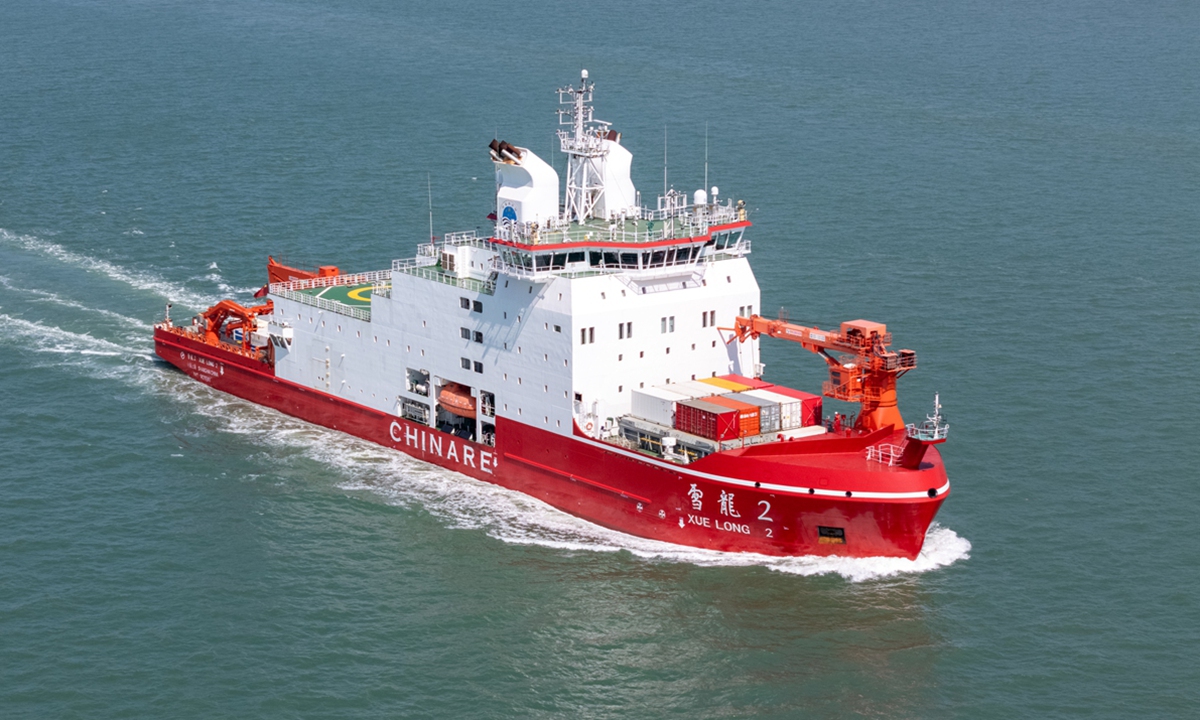
Xuelong 2, one of the ships from China's 41st Antarctic expedition team, departs on a nearly seven-month mission to Antarctica on November 1, 2024 in Guangzhou, South China's Guangdong Province. Photo: VCG
According to CCTV News on Monday, China's polar research icebreaker
Xue Long, also known as
Snow Dragon, returned to Shanghai in early April, while
Xue Long 2 is expected to return in June. The latest summer expedition to Antarctic has yielded major scientific gains, particularly in comprehensive ground-based geophysical exploration, including deployment of a large-aperture, auto-tracking optical telescope to conduct long-duration monitoring of space debris targets, further enhancing China's polar space debris monitoring system.
Geophysical exploration involves observing variations in Earth's physical fields to study the composition, structure, and dynamics of subsurface materials. In Antarctic, such operations require not only adherence to environmentally friendly principles but also consideration of equipment adaptability to extreme cold and icy surface conditions.
"In bedrock-exposed areas and coastal transition zones, we primarily used drone-mounted airborne gamma spectrometers and ground-based magnetic gradiometers for detection," Liu Guofeng, a member of China's 41st Antarctic Expedition Team, told the CCTV. "On the ice sheet, we mainly relied on electromagnetic and seismic methods, with a focus on the latter."
Seismic exploration involves creating seismic waves that travel through the ice and underlying bedrock, reflecting back to the surface upon encountering interfaces. "We deployed geophones on the surface to capture these reflected waves, enabling us to study the ice sheet and subglacial bedrock," Liu explained.
Refined data processing allowed the team to create geological models, revealing the structure and tectonic features of the ice sheet and bedrock. "This information helps us delineate the ice sheet's internal layers, determine its flow direction, and estimate potential movement rates
-key factors in understanding global climate change," Liu added. The data also supports site selection for bedrock drilling, ice core extraction, and subglacial lake exploration.
At Zhongshan Station in Antarctica, expedition members have continued space monitoring in optical and radio wavebands. A large-aperture auto-tracking optical telescope and a new astronomical observation pod were installed to enhance space debris threat warnings and support global space governance.
Currently, China's Zhongshan Station hosts four fixed-direction optical space debris telescopes and one radio astronomical telescope.
Zhang Yi, another team member, said Antarctica's atmospheric conditions are ideal for astronomical observations due to extended polar nights. "However, extreme weather like blizzards poses significant challenges for space debris monitoring," he noted. To achieve global monitoring and coordinated observations with other observatories, higher demands are placed on target tracking and network communications.
Researchers often work long hours in -30 C conditions during polar nights "This year's newly deployed telescope features optimized optical and control systems, while the observation pod enables remote operation and all-weather monitoring of both optical and radio telescopes," Zhang said.
He emphasized that monitoring the space electromagnetic environment is essential for space governance. The radio telescope's receiver system will undergo further upgrades this year to detect higher-frequency electromagnetic signals.
Global Times




